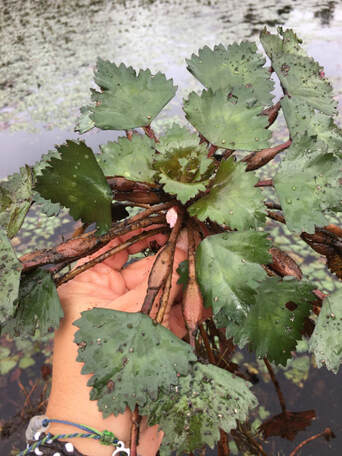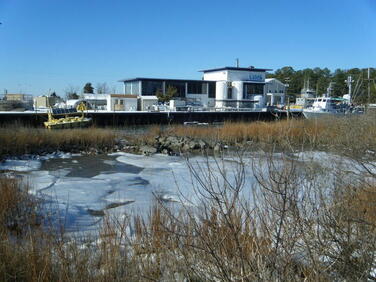 Trapa bispinsosa var. inumai. Photo by Linda Dodd, US Army Corps of Engineers. Public domain.
Trapa bispinsosa var. inumai. Photo by Linda Dodd, US Army Corps of Engineers. Public domain.
–Contributed by Kevin Heffernan, Stewardship Biologist, VDCR Natural Heritage Program
We are asking for help from the community to identify and report occurrences of the invasive two-horned trapa, an aquatic plant currently documented in ponds in Fairfax, Prince William, Loudoun, and Fauquier counties.
Two-horned trapa is an invasive aquatic plant first identified in the U.S. in Pohick Bay, Fairfax, Virginia, in 2014. Originally thought to be the first colony of the highly invasive Eurasian water chestnut (Trapa natans) in Virginia in decades, differences in the seeds of the two plants led experts to believe this was a new threat. Eurasian water chestnut bears four-horned seed pods. The Virginia colony of the new water chestnut – with seed pods of only two “horns” – was identified as Trapa bispinosa var. iinumai in 2019 (Chorak et. al, 2019).
Two-horned trapa may have already been spreading in the Potomac watershed for over a decade. Its spread threatens to undo the multi-million dollar, decades-long efforts to eradicate Eurasian water chestnut. As of late 2021, this is the only watershed in the country known to contain two-horned trapa, but this plant has the potential to spread throughout Virginia and beyond. Both Trapa species form dense floating mats that spread and cover slow-moving bodies of water, and both have the potential to obstruct water flow, inhibit recreational and commercial use of waterways, shade out submerged aquatic vegetation, and outcompete native aquatic plants.
Report any sightings of either the two-horned trapa or the related Eurasian water chestnut using the Early Detection and Distribution Mapping System (EddMapS).
Work is being done to secure funding for control projects. The goal is to keep it out of the Potomac River and prevent further spread.
For more details on identification, reporting, and management of two-horned trapa, please see the new fact sheet from the Virginia Department of Conservation and Recreation.
Resources:
Verified locations of two-horned trapa
DCR Natural Heritage fact sheet on two-horned trapa
EDDMapS invasive species reporting tool
 The Carl Hershner Teaching Marsh at the Virginia Institute of Marine Science campus in Gloucester Point, VA. Photo by Karen Duhring.
The Carl Hershner Teaching Marsh at the Virginia Institute of Marine Science campus in Gloucester Point, VA. Photo by Karen Duhring.
Marine Science Day at the Virginia Institute of Marine Science is Saturday, June 4, 10:00 am – 3:00 pm, with both online events and in-person events at the Gloucester Point campus. This year’s theme is Marshes, and activities will include tours of the Carl Hershner Teaching Marsh and exhibits on coastal marshes from the Center for Coastal Resources Management. Registration for this family-friendly event is encouraged. Visit the VIMS site for registration and additional information.
